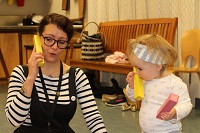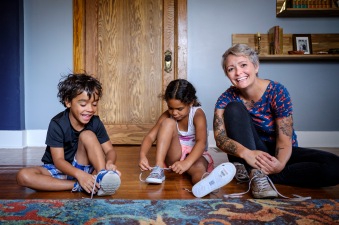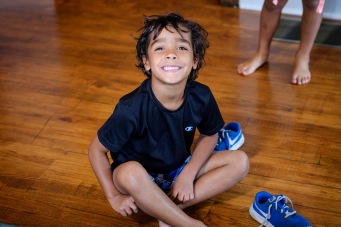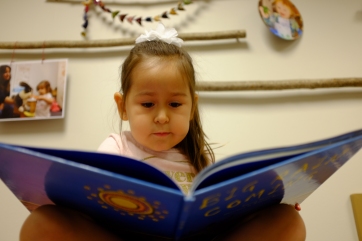We asked Exhibit Development Director and forts aficionado Katie Slivovsky to share her insights with us. Here’s what she had to say.
Does the word “fort” spark memories of secret hideouts you built in your closet, living room or yard?
Our childhood forts still evoke powerful memories, though they probably weren’t much to look at or particularly well-constructed. In fact, if we saw them today, we might think, “Someone needs to clean up that mess, pronto!”
We don’t remember our forts because they were impressive—we remember them because they were ours.
Forts were both sanctuary and home base for our developing imaginations. We built them, we made the rules (including who could enter), and because of that we were the landlords and we were empowered. Forts also provided comfort—a calm place just for us in the midst of a sometimes chaotic world.
As adults we may forget that children need a break too. Kids are aware of what’s happening around them, for worse or for better, and between challenges at school and demanding schedules, their worlds can be stressful. Forts provide a much-needed respite—if they get to design and make it themselves.
That’s why we created our Forts exhibit—to provide a space specifically designed for children to build the forts of their dreams. In doing so, we’ve learned a few things that can help parents and caregivers encourage kids to create their own sanctuary through fort building.
-
Fort-building materials are not the same as a fort-building vision.
At home, adults usually provide fort-building materials: blankets, pillows, furniture and the space to build. At Chicago Children’s Museum, we’ve created a space totally dedicated to fort-building—our walls have hooks, our blankets have loops and every piece of furniture there is up for grabs.
But that doesn’t mean we control the vision—in fact, it’s just the opposite. Even though we designed the space, we love to be surprised at how our visitors configure it. It’s probably our favorite thing about the exhibit—at any hour of the day, the space looks totally different because the kids are in charge.
Parents and caregivers can provide materials and space (with limits, of course—not all your furniture need be up for grabs), but the kids should control the vision and direction of their fort. When parents and caregivers exert too much control, the fort becomes less about the kids building it and children lose the sense of control that is so integral to creating their own sanctuary.
-
“No grown-ups allowed” is more than okay—it’s a good thing.
You’ve probably noticed that sometimes children don’t want grown-ups in their forts. In fact, sometimes we literally don’t fit—and that’s okay. A kid-sized fort that fits only one or two little ones shows that the child has been able to build a space just for them.
By letting children control the forts they design and build, they most certainly won’t be adult-sized. Remember to sit back and let children build forts that reflect their kid-sized view of the world—even if you can’t be a part of it.
-
If you are invited, it’s a huge compliment—just don’t overstay your welcome.
At Chicago Children’s Museum, when one of our child visitors invites us to play, it’s the greatest compliment a museum staffer can get. Our space—including our Forts exhibit—is designed for kids to be in charge of how they play. If they want a grown-up to come along, we’re ready and excited, but realize that we’re guests in their world.
When a child extends an invitation into their space, it means they feel safe and comfortable to share their world with you. It’s a compliment for sure—but be sure to be a gracious guest and leave them to the world they’ve created for themselves.
We love forts because of how incredibly powerful they can be for children. When they build forts, children design and construct their own sanctuaries. They set the boundaries. They get to be in charge. They can be whoever they want to be, and gain confidence as they make their own rules.
When you come to our Forts exhibit, kids can get that experience in a space designed just for fort-building—and the best part is, we’re in charge of cleaning it up.
Katie Slivovsky is the Exhibit Development Director at Chicago Children’s Museum and spent her childhood building forts in the woods behind her house on the edge of a small town in eastern Iowa. Katie has developed several exhibits at CCM and at Brookfield Zoo, including the Hamill Family Play Zoo. FORTS is one of her favorites because children have complete creative control of the space. Her daughter, Leah, is quoted in the exhibit and pictured in a fort built for her dog, Midnight.





 Pretend play fosters empathy. It’s true! Have you ever heard the phrase “walk a mile in their shoes”? When kids engage in make-believe that is exactly what they are doing. They are trying out new personas, experimenting with social roles. When they play pretend with other children they are taking into consideration the feelings of others.
Pretend play fosters empathy. It’s true! Have you ever heard the phrase “walk a mile in their shoes”? When kids engage in make-believe that is exactly what they are doing. They are trying out new personas, experimenting with social roles. When they play pretend with other children they are taking into consideration the feelings of others.







 Another essential skill shared by crawling and reading is problem solving. When little ones are learning to crawl they are planning, strategizing, and reflecting. These skills develop so they can navigate around obstacles and create new paths— the same skills later used in reading comprehension!
Another essential skill shared by crawling and reading is problem solving. When little ones are learning to crawl they are planning, strategizing, and reflecting. These skills develop so they can navigate around obstacles and create new paths— the same skills later used in reading comprehension!


